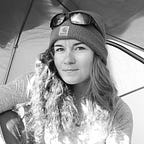Filing it all away
From logging data to seeing minke whales up close for the first time, Emma Levy files away a multitude of experiences during her first research expedition to Antarctica.
Emma Levy leans to the left side of the zodiac, snapping a photo just as a humpback whale raises its tail in the air then smacks it into the water, diving below the surface.
Capturing this kind of scene in the Antarctic Peninsula generates stunning imagery, but Levy’s photos play an integral role in our team’s research — identification.
It’s the second day of field work, and the team members on the zodiac have just encountered a single humpback whale bubble net feeding. They spend 20 minutes slowly maneuvering around the whale to get in position to tag it. Levy takes photos the whole time. After the animal is tagged, Levy looks through her shots, zooming in on the distinct markings of the flukes. She thinks I’ve seen this whale before.
Back on board the Laurence M. Gould that afternoon, Levy scrolls through the photos on her laptop. “I’m looking through my ID pictures, and sure enough it was one of the animals that we had biopsied the day before,” she says. “It’s really exciting when you have those moments of recognizing wild animals.”
While this is her first research expedition to Antarctica, being around large marine mammals is familiar territory for Levy. She has spent the past four years working on whale watching boats in Monterey Bay, California, and currently works as a research assistant at the Pinniped Cognition and Sensory Lab at UC Santa Cruz.
Her time spent on whale watching boats has given Levy the skills to identify and photograph whales, but seeing a whale from a zodiac boat provides a whole new perspective — especially when it comes to minkes.
“Minkes come to Monterey Bay but I’ve only seen them briefly” Levy says. “We usually spot just a few and they’re very shy.”
Luckily for Levy and the rest of team, the Antarctic minkes we find are far from shy.
“You can never approach whales that close in a big whale watching boat,” Levy says.
“It was really cool be able to get that close to them and see how curious they can be.”
On the zodiac, Levy juggles multiple tasks — logging data into the iPad, assisting with recovering tags, and taking ID photos. At the end of each day, Levy ensures all that data from the iPads is saved to the science drive. She also checks in with each member of the team to see who took photos or made any special notes. On an expedition like this, every single bit of data matters — whether it’s recorded on paper or an iPad, or gathered using a drone or an iPhone.
When I ask Levy how much data we have altogether, she has to think about it for a minute. “The drone data alone is roughly 70 gigs,” she says. “I think we have almost a terabyte worth of data.”
At 23, Levy is the youngest member of the team. While she’s not sure of the exact trajectory of her career in marine science, she’s grateful to have such a stellar experience under her belt already. “There’s no doubt I want to go to Antarctica again,” she says. “It’s been an awesome project to be a part of, and it will definitely open up a lot of opportunities for me in the future.”
Want to see more from the minke team in Antarctica? Check out our photos on Instagram and follow #insearchofminkes
